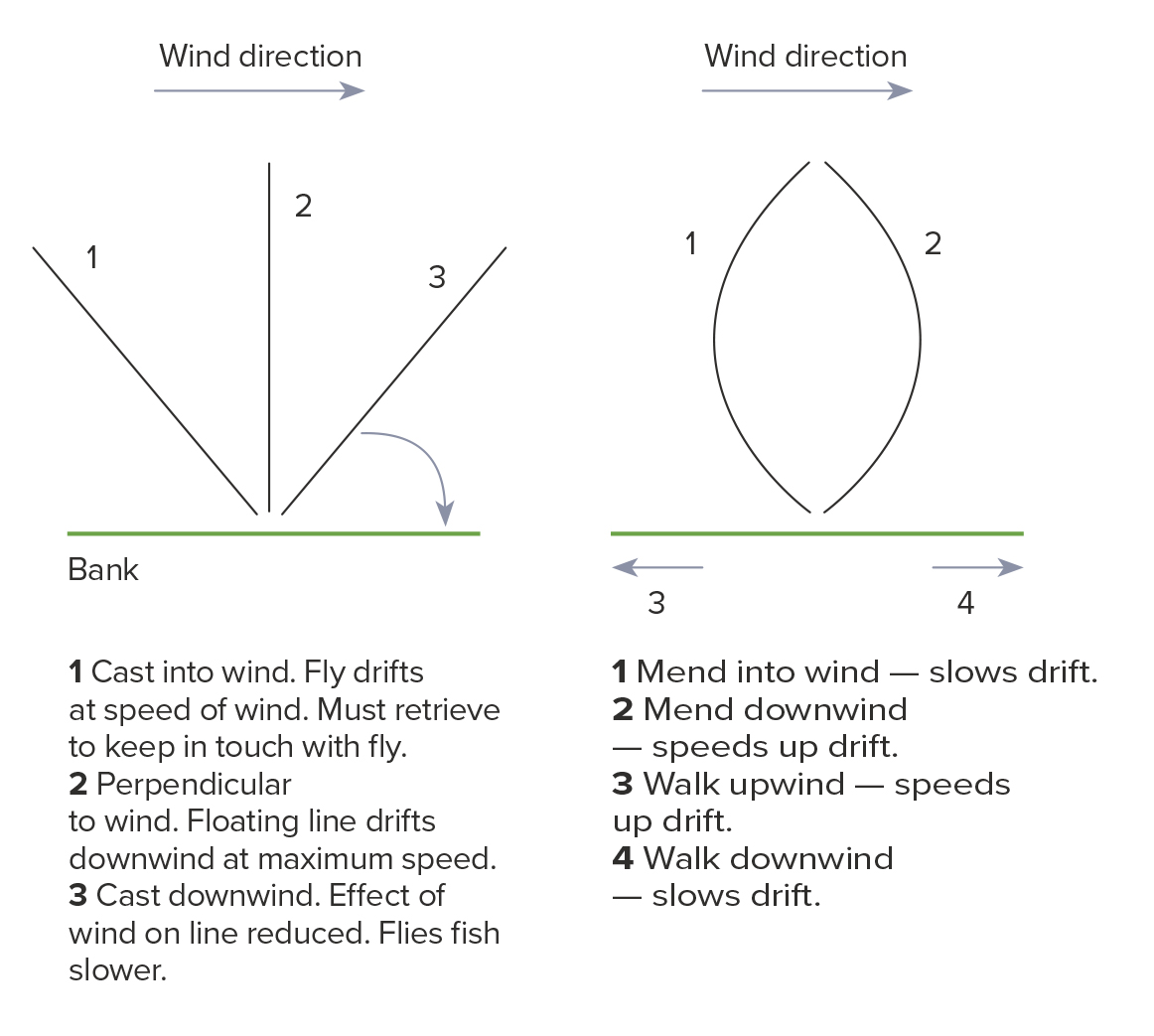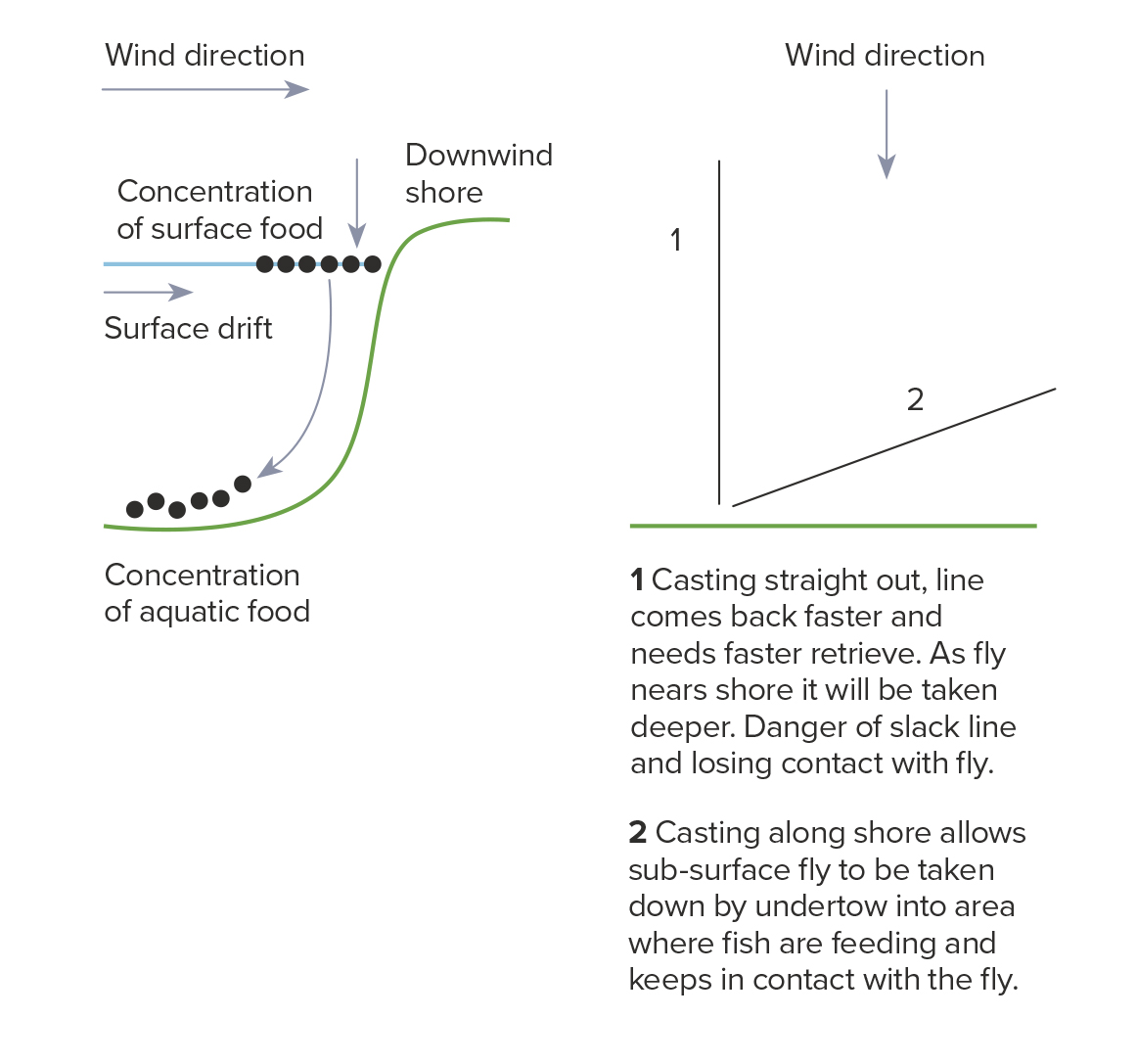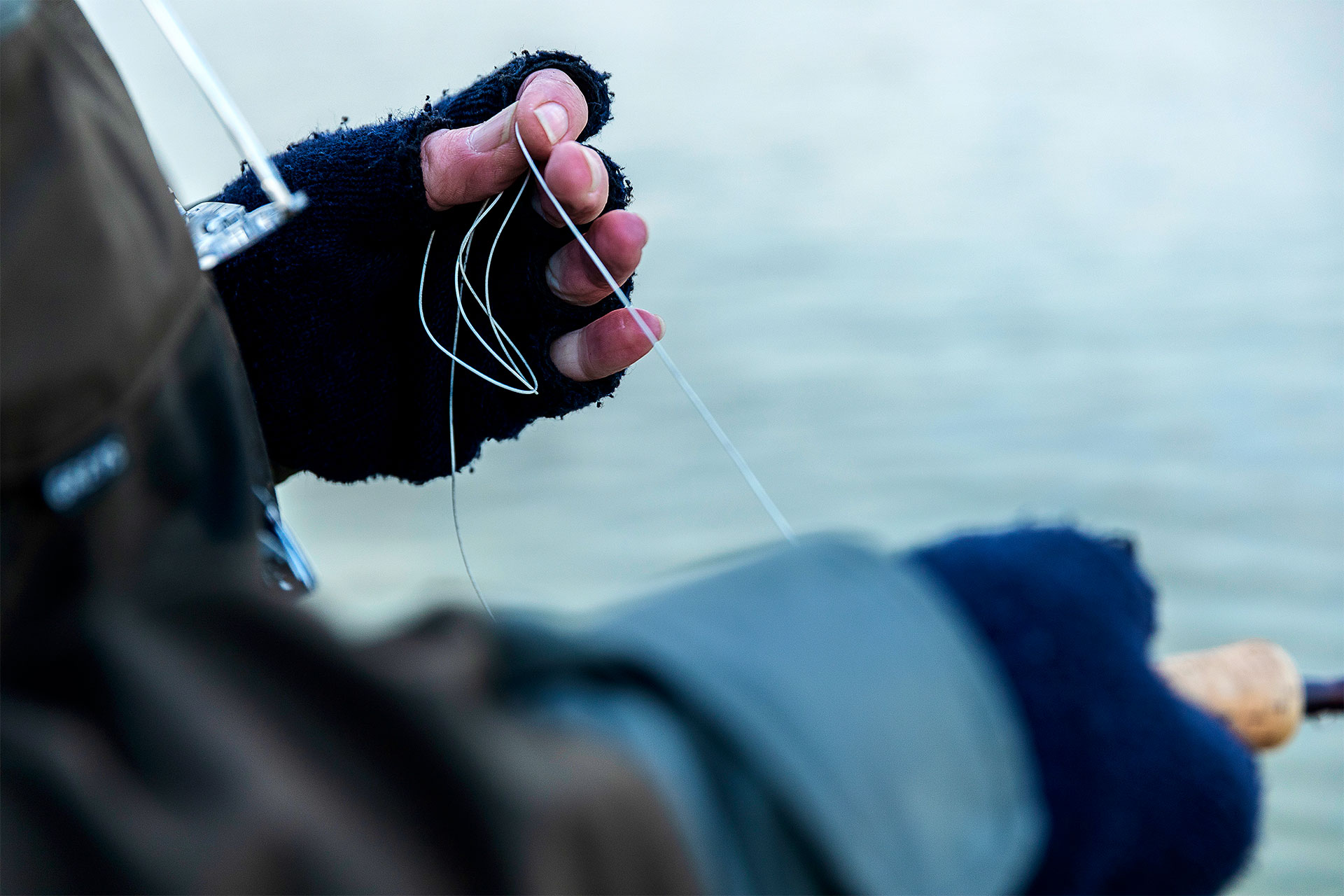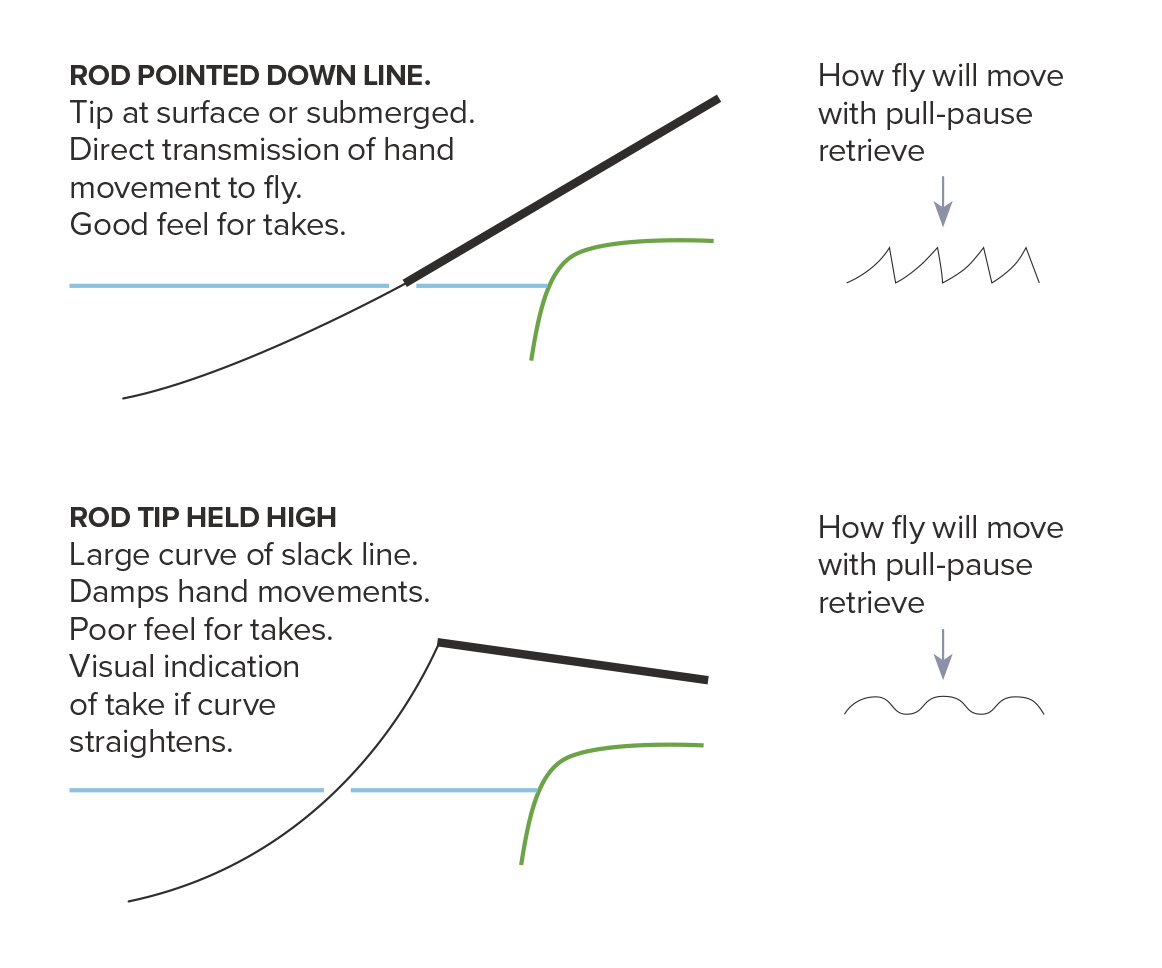Find out how flies move, ways to control your fly line and understand the effect of wind on water
You are fishing with a friend and only one of you is catching fish. Usually your friend. Exchanging locations and rods changes nothing — swap back and the successful angler catches again. Obviously, this is unrelated to position or equipment. The only remaining variable is how the flies are being retrieved. Two anglers will never retrieve their flies in exactly the same way, however hard they try.
Movement implies life. Trout see moving flies about 20 per cent further away than static flies. Retrieving flies moves them through a greater volume of water, allowing more fish to see them. Surely then, fast retrieves should always be more successful as more fish will see your fly? If only it were that simple.
Wind and water-induced motion
Stillwaters are never still. Wind creates waves and surface drift. The moving surface water produces an undertow on the downwind shore and an upwelling of water on the upwind shore. These horizontal and vertical water movements affect food items both on and beneath the surface.
It’s often sufficient to allow the wind or current to move your flies with no active retrieve. Artificial flies fished in this way will behave like natural insects.
The angle of the cast affects the retrieve. Casting perpendicular to the wind increases the speed of your flies; casting directly downwind minimises the wind’s effect; casting into the wind can produce a dead drift but you must retrieve just enough to keep in touch with the flies.
Angler-induced motion
Retrieving line, using one or both hands continuously or intermittently, is not the only way an angler moves flies.
■ Repositioning line with the rod is effective: mend line upwind to slow the flies or mend downwind to speed them up. Tracking the drifting fly-line with the rod tip reduces the speed of the flies. Lifting the rod tip raises the flies in a continuous motion. Fast lateral movement of the rod tip makes the flies dart.
■ Walking along the bank changes the speed of flies drifting with the wind. Walking downwind slows the flies; walking upwind speeds them up.
Understanding effects of wind on casting and mending

Effects of undertow on food, fly line and flies

Equipment-induced motion
The density of fly, leader and fly-line affects the retrieve. Items denser than water will sink deeper; those less dense than water will rise to the surface. Vary your retrieve by combining components of different densities. The action of a heavily weighted fly fished on a long leader and floating line is opposite to that of a buoyant foam fly fished on a short leader and a fast sinking line resting on the bottom. The former descends almost vertically, any retrieve makes it rise in the water, while the latter floats some distance above the bottom, and any retrieve makes it dive.
 Avoid habitual retrieves and assess the permutations.
Avoid habitual retrieves and assess the permutations.
Consistency
It’s vital to know what you did to induce a trout to take your fly.
You must remember how long you allowed the fly to sink, the retrieve you used, how far from the shore you were fishing and at what angle relative to the wind.
Mentally reciting what you are doing makes it easier to remember: 20 yard cast at 45 degrees downwind, flies allowed to sink for 20 seconds, retrieved with 12-inch slow pulls and three-second pauses.
Then you must remember where in the retrieve the trout took.
This system allows you to re-cast confident that you’re presenting the fly at the same depth and behaving in the same way as the successful delivery. Doing this quickly gives an excellent chance of catching another trout from the same shoal.
If you cannot recall what you did, you have learnt nothing from catching that trout.
Consistent casting is essential if you want to reproduce a successful retrieve. Casts with inconsistent amounts of slack affect fly sink rate and bite detection. Laying the line and leader out straight maximises casting distance, keeps the fly away from the fly-line and produces a tight line for optimal bite detection. If this means casting less than your maximum, go for consistent presentation over distance every time. If your line and leader do not land straight, immediately strip in line to remove any slack.
The height of the rod tip above the water affects the retrieve, pointing the tip directly down the line or even submerging it gives a very direct connection that transmits hand movements directly to the flies. Holding the rod tip high above the water with a curve of slack line dampens the action of hand movements and converts sharp pulls on the line into smooth movements of the fly.
This sounds awfully mechanical, but the idea is to eliminate as many variables as possible. Change only one thing at a time. Changing several parameters means you cannot say which one produced the successful result.
Pros/cons of of rod tip height above water and its effect on retrieves

A single change has multiple effects
When you make a successful change, it’s easy to draw the wrong conclusion. You speed up your retrieve and get a take. You conclude that “they wanted it quick”, forgetting that the faster retrieve reduced the depth of the presentation or removed the jigging action caused by your previous intermittent slow retrieve.
Do something different
Released trout can learn to avoid the fly that caught them, especially if that fly is unnaturally large or bright. They can also learn to avoid flies retrieved at high speed or with excessive motion. Small imitative flies retrieved slowly are much harder for trout to avoid because they cannot stop eating the naturals which behave in the same manner.
Fishing beadhead marabou bloodworm patterns, I get 95 per cent of my takes on the drop. Once the fly has reached the bottom, I quickly strip it back and recast. I rarely get takes when I’m moving the fly horizontally.
The slowly sinking fly may imitate the action of the natural bloodworm, but it’s just as successful when you fish it deep under a bung. When most anglers are retrieving horizontally, the vertical descent or the almost static presentation under the bung are more imitative — and crucially they are different to the retrieves that resident fish have learned to avoid.
| Match the retrieve to the fly |
|
If you are fishing imitative patterns and you want all the flies on the leader to fish properly, then they need to be imitations of creatures that naturally move at the same speed.
Fishing a bloodworm on the point with two buzzers on droppers or fishing a team with caddis pupae on the point and bottom dropper and a caddis emerger on the top dropper makes sense. We can fish them static or with a gentle sink and draw motion.
Conversely, a leader with a stick fly (caddis larva), a buzzer and a damselfly nymph will always result in two out of three of the flies acting unnaturally, as they all require different retrieves at different depths.
The retrieve is crucial to making attractor patterns and lures behave as their designers intended. Bulky Blobs retrieved fast create significant turbulence, which helps trout detect them in low visibility conditions. Flies with built-in motion such as Snakes have an optimum speed that provides the best action; in the Snake’s case that beautiful rippling effect is obtained when the long rabbit fur strip moves through the water at the right speed. This is not implying that you cannot fish Blobs or Snakes static, just that you always need to consider what the fly design is trying to achieve when deciding how to retrieve it. Watch how your flies behave in the water. When you cannot see them try to visualise the effect of your retrieve.
 Snake: fish it at a speed that makes the fur ripple.
Snake: fish it at a speed that makes the fur ripple.
|
To sum up
So many factors affect retrieves. It’s understandable why some anglers succeed when others struggle. Working out what they are doing differently is the challenge.
As the saying goes: “If you do what you’ve always done, you’ll get what you’ve always got”.
If you are not catching, change something and not just the fly. Changing your retrieve is often more productive.
Change one thing at a time and give each change a fair trial, but if there is no result in 15 minutes, change again.
On a day when it is possible to catch many fish, try altering your successful retrieve to see how much you can change it before takes cease. It requires massive willpower to do this, but you really will learn a lot.
 Success, but was it the speed at which the fly was retrieved or its depth that made this rainbow take?
Success, but was it the speed at which the fly was retrieved or its depth that made this rainbow take?